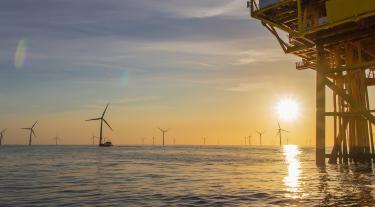A new project to build industry consensus on setting the future standard array voltage for offshore wind farms has been launched. The High Voltage Array Systems (Hi-VAS) project is the latest joint industry initiative led by the Carbon Trust as part of the Offshore Wind Accelerator (OWA) programme. It aims to understand the costs, benefits and technology challenges associated with raising the array voltage.
The wider consortium of the Hi-VAS project consists of seven wind farm developers: EnBW, Equinor, Ørsted, RWE, ScottishPower Renewables, Shell and Vattenfall. The half-million pound project is set to run until January 2022 and is being delivered by the Carbon Trust, TNEI and Petrofac. It builds on the success of previous OWA work in raising the array voltage from 33kV to 66kV, where similar industry consensus was reached five years ago.
As offshore wind turbines are set to grow beyond 15MW, it is widely agreed within the industry that the current standard array voltage of 66kV will be insufficient. A higher array voltage will be necessary to enable cost-effective string lengths and layout designs; reduce electrical losses; and ultimately enable the deployment of larger turbines. However, uncertainty remains as to what the optimum next array voltage is; the appropriate timing for making the change to the next array voltage; and the most efficient path to the next array voltage in terms of technology and regulatory development.
Whilst, in time, the array system supply chain could gradually accommodate the next generation of turbines and regulators would progressively move to accommodate changes in array system technology, a collaborative approach will accelerate this transition to ensure the industry can continue to reduce costs and increase capacity.
To achieve this, supply chain and regulatory stakeholders will be engaged throughout the project to provide insights into the practical challenges faced in raising the voltage; to provide constructive criticism and to ensure the project’s findings are supported and acted on by the industry.
The technical and regulatory changes required when raising the array voltage will be examined. Detailed cost-benefit analysis, risk analysis and preliminary design studies will be performed for a range of possible future array voltages and a range of future turbine sizes (14-20MW) to identify the next optimum array voltage.
A series of engineering design studies will examine how each component, standard, method, or regulation associated with the array system may need to adapt. Recommendations on how to address barriers identified through the project will be included in an industry roadmap to ensure the recommendations are taken up by the supply chain and regulators.
Jan Matthiesen, Director Offshore Wind at the Carbon Trust, commented:
“Offshore wind is a leading solution to tackle climate change globally and we must continue to innovate to accelerate and optimise deployment. The OWA High Voltage Array Systems project is the latest collaborative industry project to join the significant portfolio of offshore wind research and development programmes run by the Carbon Trust. By demonstrating a strong alignment among developers a clear and consistent message can be sent to the supply chain, which will ultimately accelerate the introduction of high voltage array systems and hence the next generation of wind turbines.”
High Voltage Array Systems project
ENDS
For further information please contact: The Carbon Trust press office on +44 (0) 20 7170 7050 or press@carbontrust.com.
Notes to editors
About the Offshore Wind Accelerator
The Offshore Wind Accelerator is the Carbon Trust's flagship collaborative research, development and deployment programme. The joint initiative was set up between the Carbon Trust and nine offshore wind developers in 2008, with the aim to reduce the cost of offshore wind to be competitive with conventional energy generation, as well as provide insights regarding industry standard (and best practice) health and safety requirements.
The current phase involves participation and funding from nine international energy companies: EnBW, Equinor, Ørsted, RWE Renewables, ScottishPower Renewables, Shell, SSE Renewables, Total and Vattenfall, who collectively represent 75% of Europe’s installed offshore wind capacity.
About the Carbon Trust
Established in 2001, the Carbon Trust works with businesses, governments and institutions around the world, helping them contribute to, and benefit from, a more sustainable future through carbon reduction, resource efficiency strategies, and commercialising low carbon businesses, systems and technologies.
The Carbon Trust:
- works with corporates and governments, helping them to align their strategies with climate science and meet the goals of the Paris Agreement
- provides expert advice and assurance, giving investors and financial institutions the confidence that green finance will have genuinely green outcomes
- supports the development of low carbon technologies and solutions, building the foundations for the energy system of the future
Headquartered in London, the Carbon Trust has a global team of over 200 staff, representing over 30 nationalities based across five continents.


